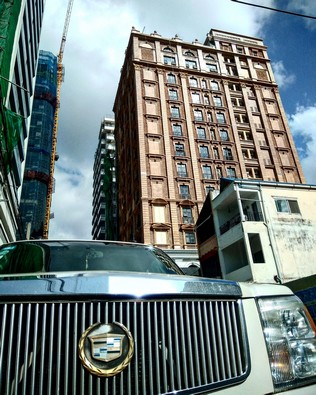Phnom Penh,
effervescent capital city of the Kingdom of Cambodia,
covering 376 square kilometres and housing 2 millions people, is
located at the confluence of 3 rivers: the legendary Mekong, the Bassac
and the great Tonle Sap. It maintains considerable charm, with more to
see that one could imagine. It exudes a sort of provincial charm and
lazy atmosphere: with French lovingly restored colonial mansions and
tree-lined boulevards, amidst monumental Angkorian architecture. Phnom
Penh is a veritable oasis compared to the modernity of other Asian
capitals. And the Cambodian hospitality is all but a legend!
Here in the capital, are many interesting touristy sites. Beside the
Royal Palace, the Silver Pagoda, the National Museum, the Toul Sleng
Genocide Museum, the Choeng Ek Killing Fields and Wat Phnom, there are
several market places selling carvings, paintings, silk, silver, gems
and even antiques at amazingly bargain prices.
The city takes its name from the re-known Wat Phnom Daun Penh
(nowadays: Wat Phnom or Hill Temple), opposite the excellent Sunway Hotel.
Built in 1373, the temple houses five statues of Buddha on a man made
hill 27 meters high.
Phnom Penh is also the gateway to an exotic land - the world heritage
site, the largest religious complex in the world, the temples of Angkor
in the west, the beaches of the southern coast and the ethnic
minorities of the North-eastern provinces. There are also a wide
variety of services including five star hotels,
fine
international dining,
sidewalk noodle shops, neighbourhood pubs, casinos and
entertaining discos.
ROYAL PALACE
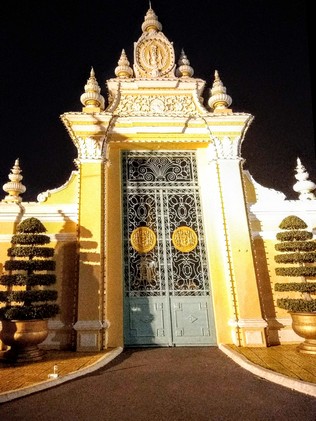
The gilt Royal Palace is one of Phnom Penh's most splendid
architectural achievements. It is home to HM Norodom Sihanouk
and Norodom Monineath. Erected in 1866 by HM Bat Norodom, great
grandfather to the current King, on the site of the old town,
especially chosen by a Commission of Royal Ministers and Astrologers
because it had great geographical significance in relation to the King,
who was regarded as a direct descendant of the gods, whose role it was
to live and govern on earth under the influence of heaven.
The Throne Hall, situated to the left of the main entrance, boasts a
59-meter tower, with a roof decoratively tiered with golden coloured
tiles. This building is used for high official celebrations,
coronations and audiences with foreign dignitaries and government
officials.
The the Napoleon II villa and the Royal Treasury lie south to the Royal
Throne Hall. North to this stands the Silver pagoda (or Pagoda of the
Emerald Buddha): featuring steps crafted from Italian marble, and a
floor consisting of more than 500 solid silver blocks. If calculated
together, they weigh nearly six tones. Surrounding the main area, stand
plush presents from foreign dignitaries. The 17th century emerald
Buddha is made of Baccarat crystal and solid gold. It weighs 90
kilograms and is adorned with 9,584 diamonds.
SILVER PAGODA
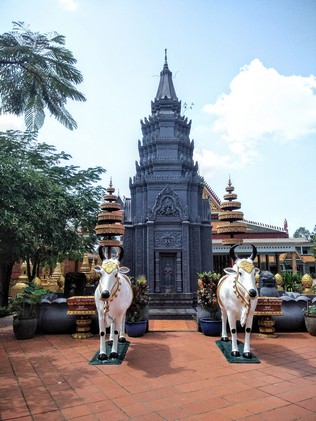
Wat Preah Keo Morakot (Silver Pagoda) is located in the southern part
of the Royal Palace. Also known as Wat Uborsoth Rotannaram, this is
where the royal family and officials held Buddhist ceremonies there.
Though this pagoda has no monks, King Norodom Sihanouk lived there for
one year when he entered the monkhood on July 31, 1947. When the King
celebrates Buddhist ceremonies, monks from other pagoda such as Wat
Unaloam and Wat Botumvattey are invited to attend. Westerners, however,
prefer to call the temple the Silver Pagoda because of the 5,329
genuine silver tiles that cover the floor.
RIVERFRONT PARK
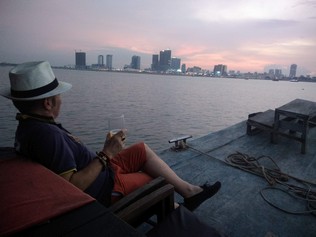
You can't miss it: the Sisowath quay is the place where all discos,
bars, roof-top terraces and tourist restaurants stand. The most famous
is the FCC Foreign
Correspondents Club. Chhrouy
Changva park is another newly attraction at the other side of the river
opposite the Royal Palace. The view of the confluence of Mekong and the
Tonle Sap is geographically unique. The sunrise over the river, in
front of the Royal Palace, is spectacular.
CENTRAL MARKET (PHSAR THMEI)
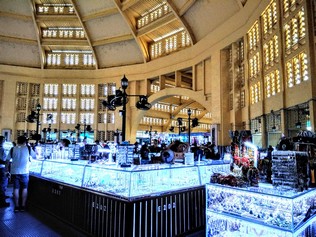
You will love shopping in and around the yellow Art Deco New Market
(Phsa Thmei), referred by locals as the Central
Market. Built by the French in the 1930's, it is shaped in the form of
a cross, with a large central dome. The 4 wings are filled with shops
of all sorts. This is, indeed, the best place to purchase gold and
silver jewellery, antique coins, Khmer hand-made gifts and electronics.
Beware of fake name brands...
Around the main buildings are stalls offering Krama (checked scarves),
stationery, household items, cloth for sarongs, and flowers.
Photographers will like to visit the fresh food section, affording a
lot of opportunities... and a unique, colourful shooting.
Opening hours are from early morning until early evening.
OLD MARKET ( PHSAR CHAS)
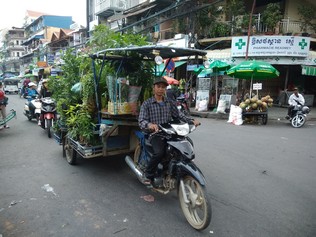
Alternatively, the Old Market (Phsar Chas) is well worth the visit. Not
at all geared to the tourist, it sells such items as vegetable, fruits,
second hand cloths, hardware, motorcycle parts and Buddhist items. In
the late afternoon, food sellers set up mats along Street 13 in
preparation for the evening market. The dinner rush hour, all around
the the most crowded market in the city, makes for a confusing, dirty
potentially photogenic scene. This is a must see during Phnom Penh tour.
WAT PHNOM HILL
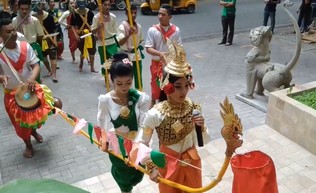
Set atop the only hill in town, Wat Phnom was erected in 1373 to house
four statues of Buddha, deposited here by the waters of the Mekong, and
discovered by a woman named Penh. The main entrance to Wat Phnom is via
the grand eastern staircase, which is guarded by lions and naga (snake)
balustrades. People come here to pray all week long (it gets quite
crowded on Sunday) for good luck and success in school exams or
business affairs. When a petitioner's wish is granted, he or she
returns to make the offering (such as a garland of jasmine flowers or
bananas, of which the spirits are said to be especially fond) promised
when the request was made.
The vihara (temple sanctuary) was rebuilt in 1926. On the West, an
enormous stupa contains the ashes of King Ponhea Vat (reigned 1405 to
1467). In a small pavilion on the south side of the passage between the
vihara and the stupa is a statue of the smiling and rather plump Madame
Penh. A bit to the north of the vihara and below it is an eclectic
shrine dedicated to the genie Preah Chau, who is especially revered by
the Vietnamese. On either side ofthe entrance to the chamber in which a
statue of Preah Chau sits are guardian spirits bearing iron bats. On
the tile table in front of the two guardian spirits are drawings of
Confucius, and two Chinese-style figures of the sages Thang Cheng (on
the right) and Thang Thay (on the left). To the left of the central
altar is an eight-armed statue of Vishnu.
TOUL SLENG GENOCIDAL MUSEUM
(S-21)
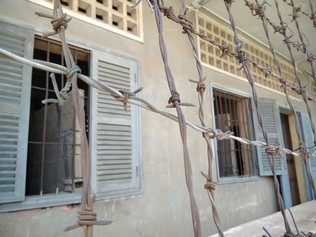
In 1975, Tuol Svay Prey High School was taken over by Pol Pot's
security force, then promptly turned into the Security Prison 21
(S-21): the largest such centre of detention and torture in the
country. Over 17,000 people held at S-21 were taken to the
extermination camp at Choeung Ek to be executed; detainees who died
during torture were buried in mass graves in the prison grounds. S-21
has been turned into the Tuol Sleng Museum, which serves as a testament
to the crimes of the Red Khmer. This is, unfortunately, the most famous
landmark in Phnom Penh.
The museum's entrance is on the western side of 113 St (north of 350
St). It opens daily from 7 until 11.30 am, and from 2 until 5.30 pm.
Like the Nazis, the Red Khmer was meticulous in keeping records of
their barbarism: each prisoner who passed through S.21 was
photographed... sometimes before and after being tortured. Several
foreigners from Australia, France and the USA were held here before
being murdered. Their documents are on display. As the Khmer
“revolution” -warmly supported by part of the Western “intelligentsia”-
reached ever-greater heights of insanity, it began devouring its own
children: generations of tortures and executioners were in turn killed
by those who took their places. During the first part of 1977, S-21
claimed an average of 100 victims a day. When the Vietnamese army
liberated Phnom Penh in early 1979, they found only seven prisoners
alive at S-21. Fourteen others had been tortured to death as Vietnamese
forces were closing in on the city. Their graves are nearby in the
courtyard.
A visit to Tuol Sleng is an interesting, though profoundly depressing
experience.
CHEUNG EK KILLING FIELD
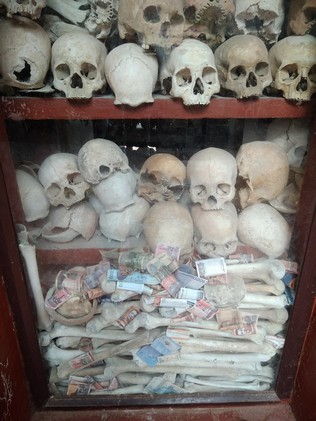
Complementing the visit to Tuol Sleng, this is where about 17,000 men,
women and children (including nine Westerners) have been executed
between 1975 and 1978, after being detained and tortured at
S-21 prison.
The majority of the victims were trucked out to Choeung Ek, at about 8
or 9 PM, to be killed. The guards took the prisoners from their
cells to the main gate where a large truck waited and told them that
they were being transferred to another place: just to prevent the
prisoners from crying, refusing to go or from escaping. In order to be
well prepared for execution, a messenger from the defence unit was sent
to the Choeung Ek Killing Field in advance to inform a permanent team
about the number of the prisoners to be killed that day. Usually, the
messenger went to the Killing Field by motorcycle in the mornings. To
ensure that a top secret was kept and also that the execution was
carried out properly, Duch, Peng, and Huy were requested to attend by
Son Sen, the Minister in charge of defence and security. Duch liked to
come, sat smoking on a mat near the pit, supervising the executions.
The remains of 8985 people, many of whom were bound and blindfolded,
were exhumed in 1980 from mass graves; 43 of the 129 communal graves
here have been left untouched. Fragment of Human bone and bits of cloth
are scattered around the disinterred pits. Over 8000 skulls, arranged
by sex, are visible behind the clear glass panels of the Memoral Stupa,
which was erected in 1988. The Killing Fields of Choeung Ek are 15 km
from Central Phnom Penh. To get there, take Monireth Blvd
south-westward out of the city from the Dang Kor Market bus depot. The
site is 8.5 km from the bridge near 271 St. A memorial ceremony is held
annually at Choeung Ek on 9 May. Made famous by the film of
the same name, this creepy place should not be visited by children.


FIRST
CLASS AROUND THE WORLD

